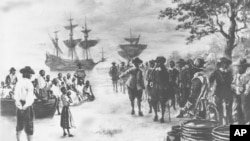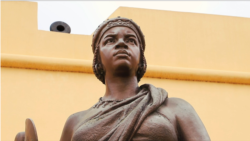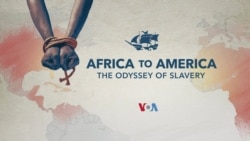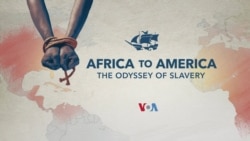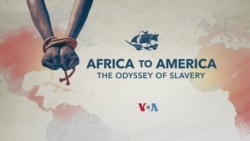In late August 1619, an English pirate ship named the White Lion sailed into the mouth of the Chesapeake Bay and anchored at Point Comfort. It deposited, according to handwritten records, “20 and odd” Africans seized from a Portuguese slave ship headed to what is now Mexico.
Those captives from Angola — sold in exchange for food and other supplies — were the first known Africans to set foot in colonial Virginia. Their arrival 400 years ago marked the beginning of slavery in English-speaking America, an institution that persisted for more than two centuries.
“This is ground zero. This is the beginning of the African imprint on America,” said Calvin Pearson, head of the local history group Project 1619, as he surveyed the former Point Comfort waterfront on a breezy spring day.
From 1525 to 1866, some 12.5 million captive Africans were put on ships bound for the Americas and Caribbean, according to Emory University’s Trans-Atlantic Slave Trade Database. Of those, 10.7 million men, women and children survived the treacherous voyages, chained and crowded below decks with little water or food. The great majority were taken to Brazil or the Caribbean but close to 400,000 arrived in what is now the United States.
“Those first Africans who landed here were destined for a life of servitude,” Pearson said, noting they were sold or traded to wealthy plantation owners in Hampton or sent to a settlement on the James River. “They had to work the crops — the corn fields, the tobacco fields. It was a life they had to endure knowing they would probably never be free.”
Africans had no official status in the American colonies — not as indentured servants nor as slaves — until Massachusetts became the first to legalize slavery in 1641. Virginia made it a hereditary condition, passing a law in 1662 saying any child born to an enslaved black woman faced the prospect of servitude for life. Eventually, the number of American slaves swelled to almost 4 million.
The Triangular Trade
Slavery came to the Americas as part of the Triangular Trade.
Ships from Europe carried manufactured goods such as cloth, guns and metal pans to Africa, selling or exchanging these items for captives picked up at ports along the continent’s western coast. These people would be delivered into bondage in the Caribbean and Americas. Many were forced into backbreaking work growing sugar, rice, cotton and tobacco — raw materials that were shipped back to Europe on the third leg of the triangle.
Though most slaves from the African continent were taken from Ghana and Senegal, more than 5 million who landed in the Western Hemisphere came from Angola. Colonized by the Portuguese, who dominated the slave trade for centuries, Angola accounted for roughly a quarter of the nearly 400,000 Africans sent to the North American mainland.
While some tribal chiefs sold captives to European slavers, other leaders tried to protect their people. One was Njinga Mbande, queen of the Ndongo and Mataba kingdoms in the 17th century. A warrior and diplomat, she fended off Portuguese and Dutch slavers throughout her 40-year reign.
“She was the greatest protector of Angolan sovereignty, and it was 40 years of fighting,” historian Isilda Hurst said from a boat cruising the Kwanza River. Njinga, she said, would hide in the river’s floating islands of tall grass, so her adversaries “could never tell where she was. … She always resisted, and she always won.”
But the Portuguese slavers ultimately prevailed.
The Kwanza, which empties into the Atlantic just south of the capital city of Luanda, was an important trade route. People who lived near its banks got swept up in the slave trade.
“It was by the river where most of the slaves were captured,” with Africans serving as middle men in the sordid deals, Hurst said.
The captives were taken to port communities, locked in holding areas, or barracoons, until they could be sold and shipped off.
Bracing the U.S. economy
Slave labor helped build the American colonies and, after they won independence from the British in 1783, the new nation.
“Slavery was so big and so important to the American economy that it was valued at more than all of America’s (other) industries combined,” said Cassandra Newby Alexander, a historian and dean of Norfolk State University’s College of Liberal Arts. “It really is symptomatic of the importance that people had to preserving and expanding slavery.”
By 1860, just before the Civil War, “the nearly 4 million American slaves were worth some $3.5 billion, making them the largest single financial asset in the entire U.S. economy, worth more than all manufacturing and railroads combined,” the writer Ta-Nehisi Coates quoted historian James McPherson in a 2014 essay in The Atlantic.
Individual states could determine whether to permit slavery. While those in the South held more slaves to tend labor-intensive crops, many whites in the more industrialized, urban North kept slaves as domestic servants or skilled laborers. And though Northern states abolished slavery — some of them gradually — they still profited from the institution.
For example, merchants in the tiny northeastern state of Rhode Island paid for ships to bring more than 100,000 captives to the New World, said Keith Stokes of Newport, who lectures on the history of Africans in America.
“Between 1705 and 1805, there are at least 900 documented slave ships that begin their voyage in Rhode Island and eventually go from West Africa through the West Indies and back to Rhode Island,” he said.
James DeWolf, who represented Rhode Island in the U.S. Senate in the 1820s, was among those who made a fortune at slaves’ expense. He invested in slave ships, in banks and insurance firms that did business with slaveholders, and in textile mills that turned cotton into garments, fueling America’s industrial revolution. After Rhode Island outlawed the shipment of slaves to North America in 1787 — and the U.S. Congress followed suit in 1807 — DeWolf’s nephew continued the slave trade illegally.
DeWolf and his extended family “engaged in slave trading on such an epic level,” said great-grandson James DeWolf Perry. He estimates they brought more than 12,000 enslaved Africans to the New World and are “probably responsible for about half a million people (who) are alive today in the Americas.”
Perry and his cousin, filmmaker Katrina Browne, are confronting the family history that shames them. They collaborated on an Emmy-nominated documentary, “Traces of the Trade” (2008), about slavery and its lingering effects. Then they co-founded the Tracing Center, a Boston-area nonprofit promoting awareness of the slave trade and its legacies affecting all Americans.
“It’s incumbent upon me to speak out about what our family did and to help other people draw the connections to the ways in which their families are connected to slavery,” Perry said. “If we bury the dark parts of a family history, we will start to assume things like that didn’t happen, and that will greatly distort our understanding of how we got here today.”
Roles of religion
Faith groups were not without sin.
The Episcopal Church, particularly in Rhode Island during the late 1600s and early 1700s, “profited directly … because donations from our members were proceeds of the slave trade,” said Nicholas Knisely, bishop of the Episcopal Diocese of Rhode Island.
Even the clergy enslaved people.
“We had slaves who were owned by the missionary organizations that were creating the Anglican churches here in the United States,” Knisely added. “We have records of slaves who were branded with the letters SPG — Society for the Propagation of the Gospel.”
Unitarian minister William Ellery Channing had an enslaved cook for his household in Newport and praised her industriousness, said Stokes, the Newport historian. Born in 1753 in West Africa, Charity “Duchess” Quamino became known as “the pastry queen of Rhode Island,” using the proceeds from her cake sales to buy freedom for herself and her children.
Quamino had a better outcome than many other African-born slaves.
While awaiting slave ships in Angola, African captives were forced by their Portuguese handlers to convert to Catholicism. Baptisms, conducted in big groups, stripped the captives of their African identity. Those who were detained in Angola would be given Christian names. Those herded onto ships often would be renamed if and when they reached a distant shore.
Religious conversion helped the Africans “embrace the gospel,” said the Rev. Paulino Koteka, a parish priest in the coastal city of Benguela. But, he acknowledged, “it destroyed their identity and their culture. Many of them suffered because of this evangelization.”
In 1985, Pope John Paul II asked Africans to forgive white Christians for their involvement in the slave trade.
Slavery’s legacy
At Angola’s National Museum of Slavery in Luanda, director Vlademiro Fortuna said nearly four centuries of involvement in the slave trade have taken a lasting toll on the country. Today, though Angola has the third-largest economy in sub-Saharan Africa, at least a third of its 30 million people live in poverty.
“This country was harmed in every single aspect. The social fabric was destroyed,” he said, pointing out that Angola wasn’t the only affected place.
“The slave trade destabilized African societies. … It wasn’t possible during the times of slavery and colonization for African societies to reorganize their political and labor systems. … Sometimes, people try to forget this part of the country’s history.”
That’s why the museum exists, he added.
In the United States, a bill backed by Democrats in the U.S. House of Representatives proposes setting up a committee to examine and remedy the “lingering negative effects” of slavery and discrimination.
At a June 19 hearing, proponents brought up the possibility of reparations or an apology, or both, for slavery and subsequent laws and policies that discriminated against blacks. They say those measures — affecting civil rights, education, housing, finance and more — contribute to ongoing disadvantages, including a racial wealth gap.
The average black family’s net worth is less than 15% of a white family’s, the Federal Reserve reported in 2017.
Senate Majority Leader Mitch McConnell opposes compensation.
“I don’t think reparations for something that happened 150 years ago, for whom none of us currently living are responsible, is a good idea,” he said the day before the hearing.
Hampton’s historic perspective
Slavery in Britain’s American colonies began in Virginia. It was also in Hampton, at the former Port Comfort site, where the system began to unravel.
In May 1861, a month after the start of the U.S. Civil War pitting 11 slave-dependent Southern states against the North, three Virginia slaves working for the Confederate Army fled to Fort Monroe. The federal stronghold had been built decades earlier near the site where the first Africans landed two centuries earlier.
The slaves sought refuge with Union troops who’d volunteered to suppress what was characterized as the Southern rebellion. Their commander, Maj. Gen. Benjamin Franklin Butler, declared the slaves “contraband of war,” a seemingly dehumanizing decision but one that meant they could legally be allowed to remain and support the Union cause.
Butler’s decision lent protection to thousands of blacks who escaped to the fort during the four-year war, and, says Project 1619 co-founder Bill Wiggins, laid the groundwork for historic measures.
Wiggins said the decision “forced” President Abraham Lincoln, in early 1863, to issue the Emancipation Proclamation, which declared “that all persons held as slaves” in Confederate states “are, and henceforward shall be free.”
That “led to the 13th Amendment, ending enslavement, and paved the way for the 14th Amendment, which provided citizenship (for the formerly enslaved) in 1866,” Wiggins said.
The fort was decommissioned as a military installation in September 2011. Two months later, President Barack Obama — son of a black African father and white American mother — designated Fort Monroe as a national monument.
At a small cemetery in Hampton, Brenda Tucker stood among graves where her forebears -- including William Tucker, believed to be the first child born to Africans in the American colonies — have been laid to rest.
Packed into slave ships from Angola, “so many did not survive. But the ones that did survive were the healthy ones, our ancestors,” Tucker said. Looking around the site, she added, “There is no way we can pass it or walk through it without thinking of an ancestor to whom we owe gratitude.”
Chris Simkins reported from Virginia and Rhode Island, with Mayra de Lasalette contributing from Angola and Carol Guensburg from Washington.




